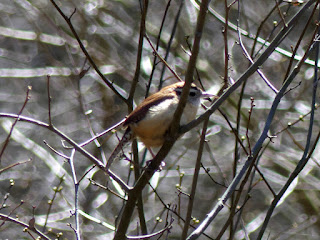Not-Just-Carolina Wren
Here's a Carolina Wren I met last March. I'm a little surprised to realize that this is the 1st Carolina Wren post I've done [1]. I did show a House Wren before, which is in the same family if not the same genus.
Before anyone asks when I was in the Carolinas, the name Carolina Wren doesn't represent the range of this species very well. Imagine a quadrilateral formed from New Hampshire, Florida, Texas, and Iowa, and you'll have a better sense of where this bird can be found [2].
This is a fairly big range with a variety of climates, and since this bird doesn't migrate [3] it must deal with these variations as best it can. One consequence is that a brutal winter can seriously deplete the northern population, though they seem to be expanding northward as our winters become milder.
Their plan is to mate for life, though most birds that do this will look for another mate if their spouse dies. If you hear someone repetitively yelling "teakettle" in the woods, it's likely to be a Carolina Wren [4].
 |
| March 20, 2023 at the Raritan Water Power Canal Photo 268021130, (c) jpviolette, some rights reserved (CC BY-NC) |
[1] Or at least it's the 1st 1 I've done since leaving Tumblr. There are no remaining traces of the old Tumblr posts; it's possible I documented Yetis, Chupacabras, and Centaurs back in those days. 😉
[2] Admittedly, Carolina Wren rolls off the tongue better than New-Hampshire-Florida-Texas-Iowa Quadrilateral Wren does.
[3] They are described as "weak fliers", which would be a very big weakness for a migrating bird.
[4] Or maybe it's 1 of our mimic birds, or a very unusual person.



Comments
Post a Comment